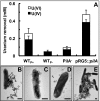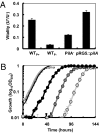Extracellular reduction of uranium via Geobacter conductive pili as a protective cellular mechanism
- PMID: 21896750
- PMCID: PMC3174638
- DOI: 10.1073/pnas.1108616108
Extracellular reduction of uranium via Geobacter conductive pili as a protective cellular mechanism
Abstract
The in situ stimulation of Fe(III) oxide reduction by Geobacter bacteria leads to the concomitant precipitation of hexavalent uranium [U(VI)] from groundwater. Despite its promise for the bioremediation of uranium contaminants, the biological mechanism behind this reaction remains elusive. Because Fe(III) oxide reduction requires the expression of Geobacter's conductive pili, we evaluated their contribution to uranium reduction in Geobacter sulfurreducens grown under pili-inducing or noninducing conditions. A pilin-deficient mutant and a genetically complemented strain with reduced outer membrane c-cytochrome content were used as controls. Pili expression significantly enhanced the rate and extent of uranium immobilization per cell and prevented periplasmic mineralization. As a result, pili expression also preserved the vital respiratory activities of the cell envelope and the cell's viability. Uranium preferentially precipitated along the pili and, to a lesser extent, on outer membrane redox-active foci. In contrast, the pilus-defective strains had different degrees of periplasmic mineralization matching well with their outer membrane c-cytochrome content. X-ray absorption spectroscopy analyses demonstrated the extracellular reduction of U(VI) by the pili to mononuclear tetravalent uranium U(IV) complexed by carbon-containing ligands, consistent with a biological reduction. In contrast, the U(IV) in the pilin-deficient mutant cells also required an additional phosphorous ligand, in agreement with the predominantly periplasmic mineralization of uranium observed in this strain. These findings demonstrate a previously unrecognized role for Geobacter conductive pili in the extracellular reduction of uranium, and highlight its essential function as a catalytic and protective cellular mechanism that is of interest for the bioremediation of uranium-contaminated groundwater.
Conflict of interest statement
The authors declare no conflict of interest.
Figures



References
-
- Lovley DR, Phillips EJP, Gorby YA, Landa ER. Microbial reduction of uranium. Nature. 1991;350:413–416.
-
- Sanford RA, et al. Hexavalent uranium supports growth of Anaeromyxobacter dehalogenans and Geobacter spp. with lower than predicted biomass yields. Environ Microbiol. 2007;9:2885–2893. - PubMed
-
- Lovley DR. Bioremediation. Anaerobes to the rescue. Science. 2001;293:1444–1446. - PubMed
-
- Istok JD, et al. In situ bioreduction of technetium and uranium in a nitrate-contaminated aquifer. Environ Sci Technol. 2004;38:468–475. - PubMed
Publication types
MeSH terms
Substances
Grants and funding
LinkOut - more resources
Full Text Sources
Other Literature Sources
Molecular Biology Databases
Research Materials

